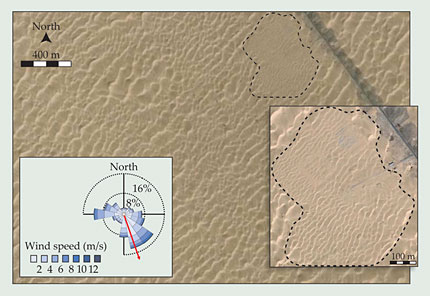Whipping up sand dunes from scratch
DOI: 10.1063/PT.3.2297
In December 2007 a collaboration led by Zhibao Dong (Chinese Academy of Sciences, Lanzhou) and Clément Narteau (Institute of Earth Physics of Paris and University of Paris Diderot) flattened 16 hectares of the Tengger desert in Inner Mongolia, China. For the next three and a half years, they returned every few months to see how the region’s seasonal winds had shaped the local topography. By October 2011 the once-flat plot of land, outlined in the figure below, had become striped with regularly spaced dunes roughly 4 m tall from peak to trough.

The Tengger desert, partially shown in this satellite image, was the site of a multiyear study of sand-dune formation. In 2008 researchers flattened the region outlined by the dashed curve. By late 2011 seasonal winds had given rise to the regular pattern of dunes visible in the inset. The chart shows the fraction of time in which wind blew in a given direction with a given speed; the arrow indicates the mean sand-transport direction. (Adapted from ref.

The study marks the first experimental test of a decades-old theory describing dune evolution under multidirectional winds. 1 That no such test had already been performed is mainly a consequence of scale: To create sand dunes in the lab, you’d need a wind tunnel the size of a football field, and you’d need to run it for years at a time. Small-scale analogues of dunes have been created in the lab using water instead of air, but such systems differ in potentially important ways from those driven by wind.
Studying natural dune fields is also problematic: Because mature dunes retain a history of the winds that shaped them, one can’t easily decouple the effects of new winds from those of old ones. To unambiguously identify relationships between wind activity and dune patterns, one needs to start, as Dong and company did, with a clean slate.
Unified dune theory
Under a steady wind, dunes tend to form with their crest lines transverse to the prevailing wind. Their formation can be understood as the result of a two-way interaction between sand and sediment. Air tends to pick up loose grains as it gains speed and to deposit them as it slows down. If the flow field around an obstruction—say, a ridge of sand—is such that wind velocity peaks upstream of the obstruction’s highest point, the wind’s net effect is to transport sediment from the obstruction’s base to its crest.
Since the 1930s, geologists have observed that in locales with regularly shifting winds, dunes sometimes form with their crest lines parallel to the mean wind direction. Some theorists speculated that such so-called longitudinal dunes were carved out by helical vortex winds arising in stiff winds. In 1987 David Rubin and Ralph Hunter of the US Geological Survey proposed a more prosaic explanation. 2 They postulated what’s now known as the gross bedform-normal transport rule: Dunes orient in the direction that maximizes the total sediment transport normal to their crest lines.
When two equally strong winds blow in roughly the same direction, the rule predicts that dunes will lie transverse to the resultant wind—the vector sum of the two prevailing winds. But if the winds oppose each other—that is, if their directions differ by more than 90°—the rule predicts the dunes should lie roughly transverse to both prevailing winds but parallel to the resultant wind. In cases where one wind is stronger or more persistent than the other, a third category of dune is possible: oblique dunes oriented neither parallel nor transverse to the resultant wind but at some angle in between.
Wind data collected during the Tengger-desert experiment show the region’s northwesterly winter winds blowing more persistently than the summer easterlies. The gross bedform-normal transport rule therefore predicts oblique dunes, oriented at roughly 50° to the mean sand-transport direction. (Because sand is dislodged only when wind speeds exceed a certain threshold, the mean sand-transport direction isn’t identical to the mean wind direction; the researchers estimate the former from the latter using sediment-transport models.) The actual dune orientations matched the prediction to within a couple of degrees, well within a standard deviation.
The field observations also confirmed theories about other aspects of dune formation. The dune spacing, about 23 m, was roughly the same as that predicted by a linear stability analysis of continuum mechanical models. The data also show dunes migrating over time, roughly a meter or so per year, in a direction close to, but not the same as, the direction of mean sand transport. Such behavior has been predicted by physical models but never conclusively observed in the field.
Winds in rewind
Confident that the theory works, Narteau next aims to tackle the sand-dune problem in reverse—to develop strategies for inferring a region’s past wind activity from its current dune patterns. The task isn’t trivial. Consider, for example, the problem of inferring two wind directions from one dune orientation: Application of the gross bedform-normal transport rule alone leaves the system indeterminate, with more unknowns than equations.
By taking into consideration spatial variations in dune orientation and physical constraints on atmospheric circulation, Narteau thinks such problems can be made solvable. Some groups have already used dune-pattern analysis to infer past changes in regional wind patterns in the Sahara and in the central US. 3 Narteau’s sights are set on more distant sands: His group is currently developing strategies to deduce atmospheric circulation patterns on dune-rich Mars and Titan.
References
1. L. Ping et al., Nat. Geosci. 7, 99 (2014). https://doi.org/10.1038/ngeo2047
2. D. M. Rubin, R. E. Hunter, Science 237, 276 (1987). https://doi.org/10.1126/science.237.4812.276
3. N. Lancaster et al., Geology 30, 991 (2002); https://doi.org/10.1130/0091-7613(2002)030<0991:LPAHDA>2.0.CO;2
V. Sridhar et al., Science 313, 345 (2006). https://doi.org/10.1126/science.1128941
